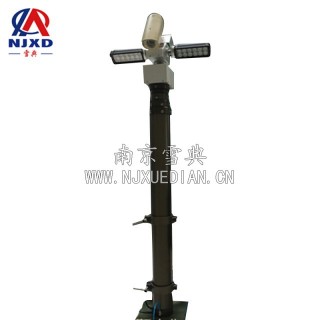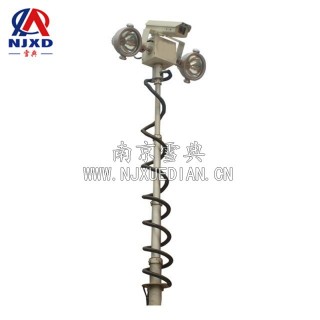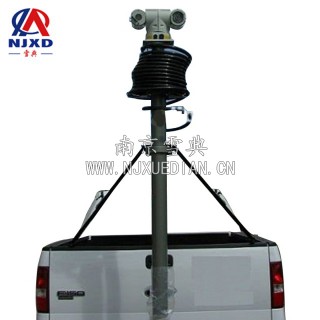NEWS
Use of lifting head
Time:2021-02-03 View:

Overview
PTZ has a wide range of applications, and various special industries also have certain demands for PTZ products. The Soviet Union was widely used in photographic propaganda films in its founding country. Due to the special use environment, the PTZ products are required to meet the special protection performance of the on-site environment. The common ones are underwater type, high temperature type, low temperature type, anti-corrosion type and explosion-proof type. Special PTZ has strict requirements on the materials used, protection levels, protection methods, etc., and must comply with the corresponding special industry standards. Among them, explosion-proof head is the most prominent.
Brief introduction of explosion-proof equipment
In many industrial sectors such as petroleum, chemical industry, coal and national defense, various flammable and explosive gases may often leak or spill out during the production, processing, transportation and storage processes, liquid and all kinds of dust and fiber. After this kind of substance is mixed with air, it may become a mixture with explosion danger. When the concentration of the mixture reaches the range of explosion concentration, once the fire source appears, it will cause serious accidents such as explosion and fire. At present, various types of explosion-proof electric device equipment such as flameproof, intrinsic safety, safety increasing, positive pressure, oil-filled, sand-filled, non-fire pattern and so on have been developed.
Examples of combustible gas, steam level and temperature groups are as follows. For other items not listed in the table, please refer to Appendix A of GB3836.1.
All explosion-proof equipment used in coal mines is class I equipment, and other explosion-proof equipment used in factories is Class II equipment. According to the maximum test safety gap or minimum ignition current score applicable to explosive gas mixture in Class II equipment, it is Level A, B and C. T1 T6 is the maximum allowable surface temperature of the equipment, T1-450 ℃, T2-300 ℃, T3-200 ℃, T4-135 ℃, T5-100 ℃, T6-85 ℃.
When dust may accumulate on the surface of class I equipment, the maximum surface temperature is 150 ℃; The maximum surface temperature allowed for Class II equipment is T4-135 ℃, T5-100 ℃, and T6-85 ℃.
For electrical equipment with voltage not exceeding 1.2V, current not exceeding 0.1A, energy not exceeding 20 microfocus or power not exceeding 25MW, after being approved by explosion-proof Inspection Department, it can be directly used in explosive gas environment of factories and underground coal mines.

Explosion-proof principle
The application principles of explosion-proof equipment generally include Gap type, contact prevention type, safety measures type and other explosion-proof principles such as using the lag characteristics of explosion to support advanced power failure. Among them, it is applicable to the gap explosion-proof principle of TV system and the explosion-proof principle of adopting safety measures.
1. Clearance explosion-proof principle
Electric spark and arc can ignite explosive mixture. The gap explosion-proof structure established by Germany is a more reliable method to prevent arc ignition and other surrounding explosive mixtures. It has a solid enough shell that can withstand the maximum explosion pressure generated by the internal explosive gas mixture to ensure that it is not deformed or damaged, and it has a certain structural gap to cool the injected combustion product to spontaneous ignition temperature lower than that of the external explosive mixture through a certain flange length. The structural clearance can be composed of plane joint surface or cylinder joint surface, and can also be composed of curved circuit, thread or barrier type. Besides that. Structures such as micropore, mesh cover, lamination, sand filling and so on also belong to the explosion-proof form of this principle.
The explosion-proof principle of safety measures
A series of safety measures are adopted on the equipment to prevent spark, arc or dangerous temperature from being generated to the maximum extent, or effective protection components are adopted to generate spark, arc or temperature cannot ignite explosive mixture to achieve explosion-proof purpose. Explosion-proof safety enhancement type, intrinsic safety type and other electrical equipment are manufactured by using this principle.

Explosion-proof equipment mark
Flameproof explosion-proof equipment "d" and intrinsically safe equipment have "ia" and "ib". Clear permanent convex mark "Ex" should be set at the obvious point of equipment shell ". At the same time, nameplate should be set at the obvious part of the equipment shell and fixed reliably. There should be "Ex" Mark, explosion-proof type mark, and the explosion-proof type, category, grade, temperature group, etc. are marked in sequence; Explosion-proof certificate number; Date of production, product number, the product standard indicates the contents that must be specified, etc.
For example, d II BT3 indicates explosion-proof Class II Class B T3 temperature Group explosion-proof equipment.
Explosion-proof equipment material
The shell of flameproof explosion-proof equipment should be able to withstand 1.5 times the actual maximum internal explosion pressure, but not less than 3.5 × 105 Pa. For the equipment used in class I mining face, the shell must be made of steel plate or cast steel; For the equipment of class I non-mining face, the shell can be made of no less than HT25-47 gray cast iron; for Class I portable equipment and class II equipment, the shell can be made of light alloy with tensile strength not less than 117.6N/mm2(12kg /mm2) and magnesium content not more than 0.5% (weight ratio).
The shell material of essential equipment can be made of light alloy with magnesium content not more than 0.5% (weight ratio) or plastic with surface resistance not more than 1×109Ω.
